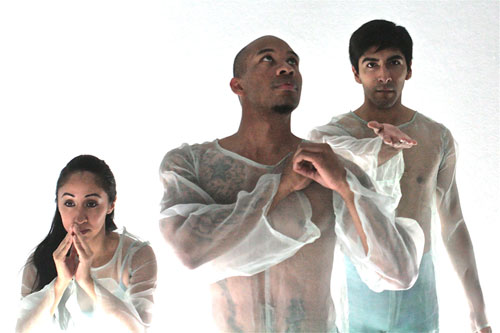Karen Stokes Dance Vine Leaf Dances

Michelle Garza, Damian Robichaux, Yahudi Castaneda in Karen Stokes Balia.
Photo courtesy of Karen Stokes Dance.
Short Story Dances
Karen Stokes on Vine Leaf Dances
Choreographer Karen Stokes switches to short form in Vine Leaf Dances, which includes three premieres – Just Us, Midnight and Distreston & Balia – and one repertory work, Prelude to Three Temperaments. As artistic director of Karen Stokes Dance (KSD) and head of the dance division at University of Houston, Stokes is one busy dance maker and educator. She brings A + C editor Nancy Wozny into her creative whirlwind.
A + C: I’ve always suspected that dances grow on vines. Tell us about the title “Vine Leaf Dances.”
Karen Stokes: The title is derived from the word “vignettes”, referring to “stories that are so small they can be written on a vine leaf.” Vine Leaf Dances features short story dances, ranging from five minutes to 25 minutes in length.
A + C: I love the idea that short form dances are a type of short story. I never thought about it that way. These days, everyone does evening-length work, and often without the skills to sustain an entire evening, in the end making it harder for choreographers to develop their voice. What is your attachment to an evening of shorter pieces? I mean, really, Paul Taylor still does that.
KS: The field does seem to be in a rather long trend of choreographers creating evening lengths. One of the challenges with the trend, as you point out,is that emerging choreographers move rapidly into producing evening length projects, often before they are ready for this challenge. Paul Taylor, Merce Cunningham, Twyla Tharp, Martha Graham, and Trisha Brown have created incredible short works. It’s good to remember our dance history.
A + C: What are some of the upsides of shorts?
KS: I like works that have been carefully edited. I love being able to focus on quality rather than quantity – to edit–and short works encourage this process.
A + C: Talk a bit about your process. How do you know if you have a short piece or an evening length on your hands?
KS: My process, as it has developed over the years, has been one in which I first develop short works that range in length from 5-15 minutes. The evening length projects that I have created over the last 12 years all began as short works. By the time I get to an evening length, I have fleshed out some solid and complete passages, which I believe helps make the evening substantive. In Vine Leaf Dances, the second half of the show is billed as a “One Act” dance.
A + C: There you go with those literary terms again. Bring us intoDistreston & Balia. And can you explain the title?
KS: Distreston & Balia is actually two short works that bookend each other with contrasting concepts. The idea for this ‘One Act dance-drama’ was born with the creation of the 12 minute Distreston in 2008, and we are now in the process of creating Balia. The concept of this work was to explore two contrasting states of mind theatrically: one that is inhabited by chains of thoughts that cannot be “slowed down,” leading to stress and darkness. The second state of mind represents a world of equanimity and balance.
As you have pointed out in the past, my work tends to anchor in a sense of place and community. These places can be real (as in Hometown – where Houston was the place) or they can be imaginary (as in The Pronoun Pieces). In exploring Distreston, I came up with a costume idea that automatically created a village – a strange and dark village from sometime in the past. Balia represents the opposite – a clear light place – perhaps in the future.
A + C: I’m excited to see Prelude to Three Temperaments again. Something about its whimsical charms makes me think it’s a signature Karen Stokes dance. For you, too?
KS: Prelude was the first piece I created after producing Hometown at Zilkha Hall in 2006. I credit the music of Stephen Montague for inspiring me to make the work in the midst of a large dose of post-production fatigue. The fast, quirky movement of Prelude contrasts the individual with a sense of togetherness. I think almost everything I have ever choreographed is about the uniqueness of the individual within a coherent community. So this is definitely a signature component. Finally, I would note the work has a “light” personality, and God knows I love to laugh! I like that you pointed out that it is a signature work – it has made me think.
A + C: Apparently, you have a day job. How do you manage your work at UH and a company?
KS: Right now, I am working hard to identify out new ways to build the infrastructure of KSD. Growing the infrastructure of KSD will provide necessary relief in the juggling of my two jobs. So, we are working on that now. I’m talking about salaries for general manager, public relations, and benefits for dancers. That being said, I must emphasize how incredibly lucky I am, doing the work I love in two incredible ways: making dances and teaching dancers. How amazing is that?
November 15-17, 2012
Karen Stokes Dance in Vine Leaf Dances
Barnevelder




Recent Comments